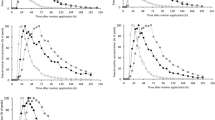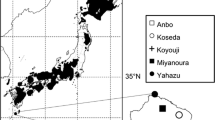Abstract
To accommodate an increased food intake with greater body size, rumen–reticulum capacity must become larger to allow heavier digesta loads. Recently, digesta load was found to correlate with age more strongly than body size. It was suggested that older animals had compromised mastication efficiency due to tooth wear and compensated for larger particles by increasing rumen–reticulum capacity to extend retention time. Herein, we constructed models and used Akaike Information Criteria corrected for small sample size to determine if digesta load was related with age or body weight in 80 female and 105 male black-tailed deer (Odocoileus hemionus columbianus). We also assessed if the presence of fetuses influenced relationships in females. Females were collected in spring, 1985–1988, and males were collected in autumn, 1980, 1982–1984, and 1988, from Hopland Research and Extension Center, Mendocino County, California. Digesta loads, fetuses, and carcasses were weighed, and animal ages were estimated. Digesta load was related to age in females and body weight in males. Our study shows that body size and age-related factors may both influence rumen–reticulum capacity.


Similar content being viewed by others
References
Barboza PS, Peltier TC, Forster RJ (2006) Ruminal fermentation and fill change with season in an arctic grazer: responses to hyperphagia and hypophagia in muskoxen (Ovibos moschatus). Physiol Biochem Zool 79:497–513
Burnham KP, Anderson DR (2002) Model selection and multi-model inference: a practical information-theoretic approach. Springer Press, New York
Carranza J, Alarcos S, Sanchez-Prieto CB, Valencia J, Mateos C (2004) Disposable-soma senescence mediated by sexual selection in an ungulate. Nature 432:215–218
Clauss M, Frey R, Kiefer B, Lechner-Doll M, Loehlein W, Polster C, Rössner GE, Streich WJ (2003) The maximum attainable body size of herbivorous mammals: morphophysiological constraints on foregut, and adaptations of hindgut fermenters. Oecologia 136:14–27
Clauss M, Nunn C, Fritz J, Hummel J (2009) Evidence for a tradeoff between retention time and chewing efficiency in large mammalian herbivores. Comp Biochem Physiol A Mol Integr Physiol 154:376–382
Demment MW (1982) The scaling of rumenoreticulum size with body-weight in east-African ungulates. Afr J Ecol 20:43–47
Forbes JM (1986) The effects of sex hormones, pregnancy, and lactation on digestion, metabolism, and voluntary food intake. In: Milligan LP, Grovum WL, Dobson A, Dobson A (eds) Control of digestion and metabolism in ruminants. Prentice Hall, Englewood Cliffs, pp 420–435
Fulbright TE, Ortega-S JA (2006) White-tailed deer habitat: ecology and management on rangelands. Texas A&M University Press, College Station
Gilbert FF (1966) Aging white-tailed deer by annuli in cementum of first incisor. J Wildl Manage 30:200–202
Hamlin KL, Pac DF, Sime CA, DeSimone RM, Dusek GL (2000) Evaluating the accuracy of ages obtained by two methods for Montana ungulates. J Wildl Manage 64:441–449
Jenks JA, Leslie DM Jr, Lochmiller RL, Melchiors MA (1994) Variation in gastrointestinal characteristics of male and female white-tailed deer: implications for resource partitioning. J Mammal 75:1045–1053
Kie JG, Bowyer RT (1999) Sexual segregation in white-tailed deer: density-dependent changes in use of space, habitat selection, and dietary niche. J Mammal 80:1004–1020
Kojola I, Helle T, Huhta E, Niva A (1998) Foraging conditions, tooth wear and herbivore body reserves: a study of female reindeer. Oecologia 117:26–30
Loe LE, Mysterud A, Langvatn R, Stenseth NC (2003) Decelerating and sex-dependent tooth wear in Norwegian red deer. Oecologia 135:346–353
Massey BN, Weckerly FW, Vaughn CE, McCullough DR (1994) Correlations between fecal nitrogen and diet composition in free-ranging black-tailed deer. Southwest Nat 39:165–170
McArthur C, Sanson GD (1988) Tooth wear in eastern grey kangaroos (Macropus giganteus) and western grey kangaroos (Macropus fuliginosus), and its potential influence on diet selection, digestion, and population parameters. J Zool 215:491–504
McCullough DR (2001) Male harvest in relation to female removals in a black-tailed deer population. J Wildl Manage 65:46–58
McCullough DR, Beier P (1986) Upper vs lower molars for cementum annuli age-determination of deer. J Wildl Manage 50:705–706
Mysterud A, Bonenfant C, Loe LE, Langvatn R, Yoccoz NG, Stenseth NC (2008) Age-specific feeding cessation in male red deer during rut. J Zool 275:407–412
Parra R (1978) Comparison of foregut and hindgut fermentation in herbivores. In: Montgomery GG (ed) The ecology of arboreal folivores. Smithsonian Institution Press, Washington, pp 205–229
Pérez-Barberìa FJ, Gordon IJ (1998) Factors affecting food comminution during chewing in ruminants: a review. Biol J Linn Soc 63:233–256
Ramzinski DM, Weckerly FW (2007) Scaling relationship between body weight and fermentation gut capacity in axis deer. J Mammal 88:415–420
Rolandsen CM, Solberg EJ, Heim M, Holmstrom F, Solem MI, Saether BE (2008) Accuracy and repeatability of moose (Alces alces) age as estimated from dental cement layers. Eur J Wildl Res 54:6–14
Severinghaus CW (1949) Tooth development and wear as criteria of age in white-tailed deer. J Wildl Manage 13:195–216
Short HL, Remmenga EE, Boyd CE (1969) Variations in ruminoreticular contents of white-tailed deer. J Wildl Manage 33:187–191
Skogland T (1988) Tooth wear by food limitation and its life-history consequences in wild reindeer. Oikos 51:238–242
Sokal RR, Rohlf F (1995) Biometry: the principles and practice of statistics in biological research. W. H. Freeman and Company, New York
Spalinger DE, Robbins CT (1992) The dynamics of particle flow in the rumen of mule deer (Odocoileus hemionus hemionus) and elk (Cervus elaphus nelsoni). Physiol Zool 65:379–402
Spalinger DE, Robbins CT, Hanley TA (1986) The assessment of handling time in ruminants: the effect of plant chemical and physical structure on the rate of breakdown of plant particels in the rumen of mule deer and elk. Can J Zool Rev Can De Zool 64:312–321
Van Deelen TR, Hollis KM, Anchor C, Etter DR (2000) Sex affects age determination and wear of molariform teeth in white-tailed deer. J Wildl Manage 64:1076–1083
Van Soest PJ (1994) Nutritional ecology of the ruminant, 2nd edn. Cornell University Press, Ithaca
Veiberg V, Mysterud A, Bjorkvoll E, Langvatn R, Loe LE, Irvine RJ, Bonenfant C, Couweleers F, Stenseth NC (2007) Evidence for a trade-off between early growth and tooth wear in Svalbard reindeer. J Anim Ecol 76:1139–1148
Veiberg V, Mysterud A, Irvine RJ, Sormo W, Langvatn R (2009) Increased mass of reticulo-rumen tissue and contents with advancing age in Svalbard reindeer. J Zool 278:15–23
Weckerly FW (1993) Intersexual resource partitioning in black-tailed deer: a test of the body size hypothesis. J Wildl Manage 57:475–494
Weckerly FW (2010) Allometric scaling of rumen-reticulum capacity in white-tailed deer. J Zool 280:41–48
Weckerly FW, Nelson JP Jr (1990) Age and sex differences of white-tailed deer diet composition, quality, and calcium. J Wildl Manage 54:532–538
Weckerly FW, Vernon CB, Chetkiewicz C-LB, Ricca MA (2003) Body weight and rumen-reticulum capacity in tule elk and mule deer. J Mammal 84:659–664
Acknowledgments
This research was funded by the California Agricultural Experimental Station, California Department of Fish and Game, HREC, Alamo Safari Club, and A. Starker Leopold Endowed Chair. Our gratitude goes out to A. Murphy, R. Timm, T. Blankenship, K. Mayer, R. Mohr, E. Loft, J. Booth, R. Keiffer, B. Whittaker, C. Bryne, M. O’Bryan, T. Kucera, P. Beier, W. Carmen, P. Mulligan, R. Evett, K. Arha, J. Garcia, G. Fong, K. Gleason, N. Menzies, L. Branch, and L. Merkle for assistance in data collection. The cooperation over the years of numerous public hunters was essential to the project and we are grateful. A special thanks to J. Duarte for commenting on earlier drafts of the manuscript. This research was conducted under animal use protocols approved by the University of California, Berkeley and Davis, and HREC, and a memorandum of understanding and collecting permits from the California Fish and Game Commission.
Author information
Authors and Affiliations
Corresponding author
Additional information
Communicated by H. Kierdorf
Rights and permissions
About this article
Cite this article
Duarte, A., McCullough, D.R. & Weckerly, F.W. Does rumen–reticulum capacity correlate with body size or age in black-tailed deer?. Eur J Wildl Res 57, 1131–1136 (2011). https://doi.org/10.1007/s10344-011-0525-y
Received:
Revised:
Accepted:
Published:
Issue Date:
DOI: https://doi.org/10.1007/s10344-011-0525-y




